A table in a top-secret location in Asheville is covered with catalogs, flyers, letters and notebooks stretching back to before the space-age 1950s. There are photos, magazine articles and pages filled to the margins with symbols translatable only by those versed in electronics. But in these symbols, doodles and names scratched out in pen are hints of the life and work of one of modern music’s paragons.
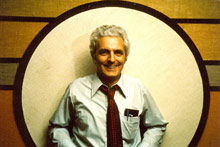
Michelle Moog-Koussa, daughter of the late Bob Moog (rhymes with “vogue”), walks over from a set of floor-to-ceiling shelves filled end-to-end with boxes that are heavy with old papers and file folders, and lays down a blue notebook.
“We just ran across something the other day,” she says, leaning over and delicately unfolding leaves of slightly translucent paper covered in multicolored lines and strange squiggly symbols. It is the original hand-drawn schematic for the Minimoog synthesizer, one of her father’s most iconic developments. “If you give this to the right person, it is enough to make them plotz,” she says.
“Plotz” is a Yiddishism that indicates extreme excitement. Its literal translation is “to explode,” and it’s not hard to imagine it as the reaction an electronic-music geek would have unfolding those same pages. The resulting quote could be, as already expressed on a sticky note affixed to the folder, “Holy Moog!”
Bob Moog’s impact on the musical world is well known and well documented. From his championing of the theremin to the Moogerfooger to the Asheville-based Moog Music factory, Moog’s name is attached to most anything that electronically alters sound. And all that action happened in the era of records, tapes and mass media. There shouldn’t be much we don’t already know about Moog. But it turns out, there is.
In 2007, two years after her father’s death, Michelle and other family members began clearing out an old aluminum shed on the property that Bob Moog called home. Inside, they found a heap of drawings, correspondence, reel-to-reel tapes and prototypes of instruments, all covered in a fine layer of dusty mold thanks to the less-than-watertight shed.
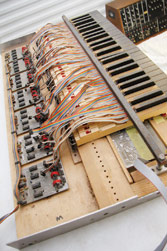
“It blows me away the things he was working on … weird things we don’t even know what they are,” says former Electronic Musician magazine editor Gino Robair, who Moog-Koussa met at a music conference. “The fact that there’s this whole world of stuff below the surface is pretty historic.”
The collection has since been transferred to more climate-controlled locations, but it’s still out of the public eye, a situation Moog-Koussa wants to change. As the executive director (and only paid employee) of the Bob Moog Memorial Foundation for Electronic Music, she has been championing the archive, trying to secure the funding needed for a permanent “Moogseum” in Asheville.
The instruments and experiments of the archives would make up the core of the ambitious museum, but a great deal of design has gone into emphasizing interactivity and student outreach, a passion Moog-Koussa says her father held dear. The foundation is still looking for a location and funding for the project, and the target horizon is still three to five years away. Still, the effort recently got a good bump from a $600,000 grant from the Buncombe County Tourism Development Authority. To build momentum, the foundation is hoping to open a scaled-down Moogseum Beta sometime this summer in the lower level of the Asheville Area Arts Council, that will serve not only as a display, but as a home base for foundation operations and a youth program.
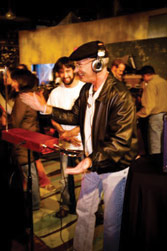
In the meantime, an installation called the Minimoogseum is set to open in the foyer of The Orange Peel, just in time for the second Enter the Mind of Moog event on Thursday, May 21, and Moog’s 75th birthday. The 7- by 5-foot case will include photos and ephemera from the archives, but will also contain a working theremin playable by anyone standing in front of it.
Like the first Mind of Moog in 2007, this one will feature theremin- and synthesizer-playing stations, and a collection of local musicians recording new music, track by track, onstage. The Foundation’s volunteer creative director, Dave Hamilton, manned the recording equipment at the first event and has gathered another group of musicians to push the recording to four songs. And there were plenty of takers. About 20 musicians are participating this year.
“The support we have received from the local music scene has been phenomenal,” he says. “In fact, I wish I had a better word for it.”
And there seems to be more Moog momentum this year as well. In August, the Museum of Making Music in Carlsbad, Calif., is opening the exhibit Waves of Inspiration: The Legacy of Moog, featuring some of the archive materials.
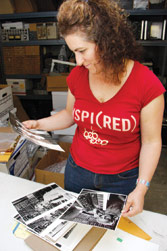
“It is really an incredible collection,” says museum curator Tatiana Sizonenko, noting that there are insights into Moog not duplicated anywhere else. “It’s all very important.”
And earlier this month, organizers of Moogfest announced that the annual musical event will move from New York to Asheville in September.
“People already know of Asheville as Moog central,” says Jeff Knorr, co-owner of Collapseable Studios, who will be one of the performers at the Mind of Moog. Hamilton, who organizes the events, seconds that sentiment, saying that musicians who come to town often stop by Moog Music to pick up a new piece of equipment. A Moogseum, he agrees, would be a certain draw, but he notes that Moog himself might have been uncomfortable with the attention.
“One of his startling characteristics was his humble nature,” Hamilton says.
“Beyond a fetish”
One by one, Moog-Koussa pulls instruments in various stages of completion from the shelves. There’s an early prototype of a multi-touch-sensitive keyboard—which reads the location and velocity of a finger and produces a corresponding sound – with its wiring and circuitry exposed. There’s the prototype keyboard of the Voyager synthesizer (a model recently re-released in limited number by Moog Music) and a modulator four feet long that requires two to carry it. There are shelves of reel-to-reel tape marking Moog’s collaboration with musicians that led to the electronic music explosion of the 1970s and 1980s.
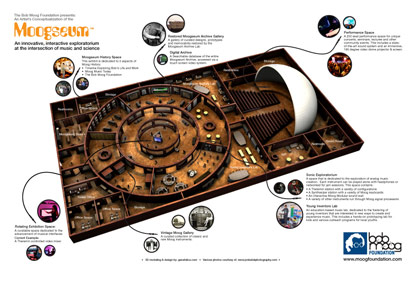
And there are things unidentifiable, their meaning or purpose hidden until someone who is familiar with the technology, or who has worked with Moog, can translate it. And Moog worked with a lot of people, many of whom approached him with an idea, knowing he had the engineering chops to figure it out. A page in a book labeled “1967-1969” for instance, is marked simply “The Beach Boys” followed by a series of notations.
“There’s a complementary component,” Moog-Koussa says. “He didn’t do it all himself. Finding some of those people with a wide reach who are willing to connect us to musicians is going to be a big step. And I think we’ve found some of those people.”
The making of the Moogseum
— B.P.
The Bob Moog Foundation has big plans for an Asheville-based museum dedicated to the man’s legacy and work. The planned facility (a location for which has not been chosen) could be built in three to five years, the foundation estimates. But the foundation isn’t waiting—they’ll unveil the Moogseum in phases.
• The Minimoogseum, a permanent installation in the foyer of The Orange Peel, will be unveiled on May 21 as part of the Entering the Mind of Moog event. The 7- by 5-foot display will show off some of the foundation’s archives, and also feature a working theremin.
• The Moogseum Beta is expected to open sometime this summer. A scaled-back museum (tentatively planned for the lower level of the Asheville Area Arts Council) will allow more unveiling of Moog’s archives, and also provide a hands-on instrument area and space for youth activities.
• The Moogseum, a multimedia museum that will encourage music making and in-depth exploration of Moog’s legacy—including a performance space – will take three to five years to develop and fund. The project got a boost earlier this year: a $600,000 grant from the Buncombe County Tourism Development Authority.
For more information or to contribute, contact the Moog Foundation at www.moogfoundation.org, www.moogseum.com or 683-7261.
Apart from raising funds for the museum, Moog-Koussa’s job is to raise funds for the collection to be properly archived. Tapes need cleaning and restoring, and boxes of papers need sorting.
In January, Moog-Koussa packed up a few select items and headed to the National Association of Music Manufacturers conference in Anaheim, Calif., where she ran into Robair.
“It goes beyond a fetish of electronic music,” Robair says. “It’s an American story of someone who came up with an idea and followed his dream and influenced music in a way that few others have.”
For every instrument, prototype and jotted-down note, there is a story, Moog-Koussa says. And connecting those dots will give an even deeper understanding of Moog’s level of drive and innovation.
“I don’t think he ever even looked back,” Robair says. “If something didn’t work out, he just set it aside and moved on, which leaves a big trail.”
In other words, it’s enough to make you plotz.
who: Bob Moog Foundation
what: Enter the Mind of Moog: Spring fundraiser for the planned Moogseum
where: The Orange Peel
when: Thursday, May 21 (6 to 10 p.m. $15,$5 for children under 16. www.moogfoundation.org or 683-7261)
why: Come check out a working version of the planned Moogseum, and celebrate the 75th birthday of the late Bob Moog. Experience the interactive instrument-based exhibits—a huge hit at past Moog events. Also on hand will be an archival exhibit and interactive timeline. Other highlights: A cake challenge from Asheville’s artisan bakers and the Bob Moog Foundation house band.



Thank you Bob, you live on in so many people!!
Too bad the Xpress “honored” Moog with such a hideous cover. That’s the worst cover EVER on a MountainXpress and I have been a loyal reader for a long time. Bring back the adults, please.
I am so proud and happy for all of you that the museum is becoming a reality bit by bit.
Much like modules for a synthesizer the pieces are coming together and I can’t wait to see the final result.
Amin Bhatia
PS Sorry about the corny “modules” analogy!
it is so great to be involved with this (i’m working on the analog tapes), and to see a posting from amin! (holy poof i love your stuff.) the moogseum will be a serious mecca for synth people.